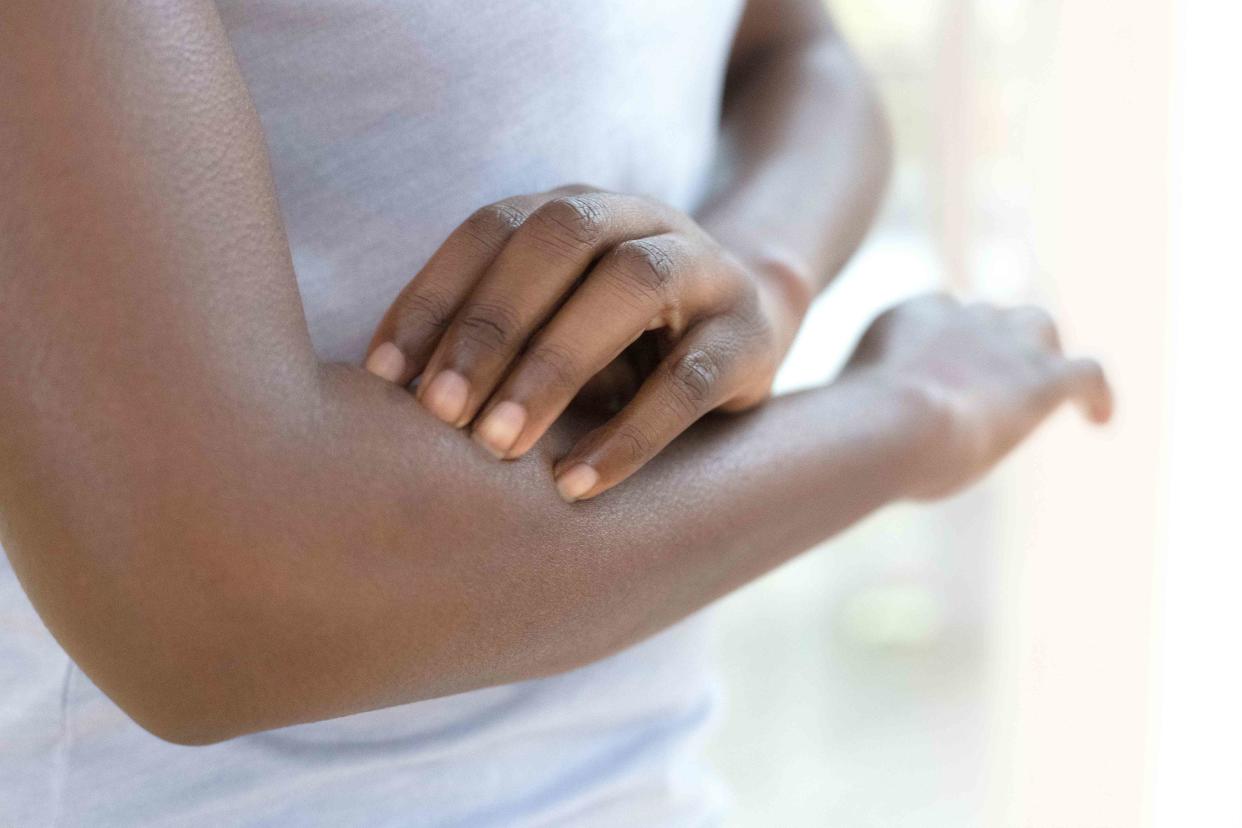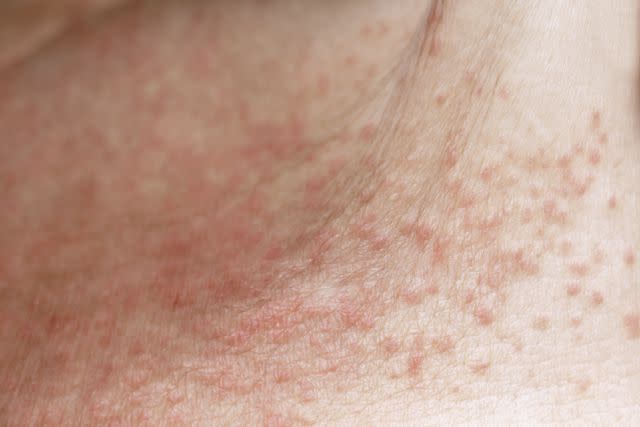What Is Heat Rash?

Science Photo Library / Getty Images
Medically reviewed by Susan Bard, MD
Heat rash is a skin irritation you can develop from excessively sweating in hot, humid conditions. The rash can form when your sweat ducts and glands become blocked. Heat rash is also called miliaria, sweat rash, or prickly heat.
Heat rash is most common among young children, particularly newborns between 1 and 3 weeks old. But someone of any age can develop heat rash. In fact, up to 30% of adults living in hot, humid climates experience heat rash.
Heat rash is best treated by getting into a cooler, less humid area. It is also important to keep the affected area cool and dry.
Symptoms of Heat Rash
Heat rash usually looks like a cluster of red pimples or small blisters. This rash is most likely to emerge in areas where your skin touches other folds of skin, such as your:
Neck
Groin
Breasts (underneath)
Elbow creases
Adults may also develop heat rash in places where their clothes touch their skin, such as their torso.
If you have heat rash, your skin also may feel very itchy. You may even feel a prickly or tingling pain where the rash is located.

Arisa Thepbanchornchai / Getty Images
Types of Heat Rash
Your symptoms can be different based on the type of heat rash you have. The type of heat rash you have depends on how deep down your skin is affected. The different types of heat rash are:
Miliaria crystallina: This type of heat rash is the mildest form, affecting only the top layer of your skin. The blisters are 1 to 2 millimeters and look like water droplets. The clear, fluid-filled bumps can break easily. Because the rash affects only the top layer of the skin, there is usually no inflammation.
Miliaria rubra: This type of heat rash is the most common. It occurs deeper in the skin and so involves inflammation. Because of the inflammation, the rash may be itchy and painful (or prickly, hence the name prickly heat). The blisters are larger than those of miliaria crystallina.
Miliaria pustulosa: This type of heat rash occurs when the inflamed bumps of miliaria rubra fill with pus. This may mean there is a bacterial infection.
Miliaria profunda: This less common form of heat rash affects the deepest layer of your skin. It causes firm, raised lesions that are the same color as your skin. You may have no symptoms, or you may be very itchy.
How Long Does Heat Rash Last?
How long heat rash lasts depends on the type of heat rash you have. Miliaria crystallina usually appears in the days after you've sweat in the hot environment and goes away in as quickly as 24 hours. Miliaria profunda can develop within minutes to hours of sweating and go away less than an hour after you stop sweating. Most cases of heat rash will get better as soon as you move to a cool environment.
What Causes Heat Rash?
Heat rash is triggered by blocked sweat glands and ducts. The blockage could be caused by substances like bacteria. The blockage causes sweat to leak into the outermost layer of your skin, causing swelling and further duct blockage. The sweat being trapped under your skin can lead to heat rash.
Sweating is the most common cause of heat rash, meaning hot or humid conditions are where heat rash is most common. Having a high fever can also lead to heat rash. Some other possible causes of heat rash include:
Tight clothing
Patches placed on your skin for medical purposes
Strenuous physical activity
Morvan syndrome (a rare disease causing excessive sweating, or hyperhidrosis)
Medications that cause sweating, such as the high blood pressure medication Catapres (clonidine)
Heat rash can also impact people who have an illness or injury that keeps them in bed or in a chair for extended periods of time. The lack of movement causes sweat and heat to accumulate under them, which can lead to heat rash. Similarly, people sleeping with too many blankets or in overly warm pajamas can develop heat rash.
Although anyone can get heat rash, infants and children are at a higher risk because their sweat ducts are not fully developed.
How Is Heat Rash Diagnosed?
There are no tests available to diagnose heat rash. Typically, a healthcare provider can diagnose heat rash just by looking at your skin.
A healthcare provider may use a dermatoscope to look at the rash, especially if you have darker skin. This small camera-like device allows the provider to get an unobstructed view of the rash. If the healthcare provider is still unsure if your rash is heat rash or something else, they may suggest a biopsy of the skin.
How Is Heat Rash Treated?
To treat heat rash, you need to decrease your sweating and unblock your clogged sweat ducts. The most effective treatment for heat rash is getting out of the hot, humid environment and making your skin cool and dry.
You can get into an air-conditioned space or put on fan to circulate the air. You can also use a cool compress to bring down the temperature of your skin, but you need to be sure to dry your skin thoroughly after using the compress. Using a fan can help your skin dry more quickly.
More specific treatments are recommended based on the type of heat rash you have. For instance, miliaria crystallina usually does not require treatment other than keeping the skin dry and cool because the rash usually resolves on its own. For miliaria rubra, the goal is to reduce inflammation, so corticosteroids like Kenalog (triamcinolone) 0.1% cream may be recommended for one to two weeks.
If you develop miliaria pustulosa, your healthcare provider may recommend topical antibiotics such as Cleocin (clindamycin) to treat the infection. There is not a lot of research on the treatment for miliaria profunda, and treatment would typically follow the general techniques for managing heat rash.
Other things you can do to help manage heat rash, particularly the itchiness, include the following:
Use pine tar soap: Pine tar soap can be used to reduce itching and inflammation from skin conditions like heat rash. Simply lather and apply to affected area. Then, rinse and pat your skin dry.
Take a colloidal oatmeal bath: If your rash is particularly itchy, you may want to try putting a few drops of colloidal oatmeal (ground oatmeal that is suspended in a liquid) in a bath. Research indicates that colloidal oatmeal extract may have anti-inflammatory and antioxidant effects, which can help reduce itchiness.
Take a baking soda bath: Sometimes putting baking soda in a bath can help calm itchy skin. Put 1/4 cup of baking soda in a warm bath and soak for 10 minutes to relieve itching. Be sure to dry off completely when you are done.
Keep your skin dry: Powder can help keep your skin dry while it heals. If you are on bed rest, you should try to adjust your position to keep your body from sweating. And if you have a condition that is causing a fever, try managing that to bring down your temperature and prevent sweating.
Wear loose clothing: Wearing breathable clothing can help your skin heal by preventing friction that can come with tighter-fitting clothing. You also may want to ask your healthcare provider about removing any bandages or patches that may be keeping air from getting to you skin.
Exfoliate the skin: Removing dead skin cells can help unblock your sweat glands.
Avoid using ointments or creams when treating heat rash. A healthcare provider can advise you on which treatment options would be best for you and your type of heat rash.
How Do You Prevent Heat Rash?
Because heat rash is caused by blocked sweat glands, anything you can do to reduce how much you sweat can help prevent heat rash from developing. For instance, dermatologists typically recommend that you wear lightweight, loose-fitting clothes made of cotton.
Dermatologists also suggest keeping your skin from overheating by taking cool showers, using fans, and spending time in air conditioning when possible. You also should plan your activities or exercise regimens during the coolest part of the day.
When to See a Healthcare Provider
Most heat rashes go away on their own. However, if your heat rash is still there after three or four days, you should see a healthcare provider. You should also see a provider if the rash seems to be getting worse. In some cases, heat rash is caused by an infection that will need to be treated.
You should also contact your healthcare provider if the rash is making you severely itchy or if the rash is swollen or has pus.
If you are experiencing signs of a more severe heat-related illness, such as heat exhaustion or heat stroke, you should also see a healthcare provider. These symptoms include:
Dizziness
Confusion
Trouble breathing
Editor's Note: There is a chance that what you think is a heat rash is not actually a heat rash. Generally, you should seek medical attention for any type of rash if:
You have a rash all over your body
You have a fever with your rash
Your rash is sudden and is spreading quickly
Your rash is starting to blister
Your rash is painful
Your rash appears infected
A Quick Review
Heat rash is an irritation of the skin that typically occurs in hot, humid conditions that make you sweat excessively. Your sweat glands become blocked, resulting in an itchy, blister-like rash. There are different types of heat rash depending on how deeply the gland is blocked. Most times, getting into a cool environment and drying your skin is enough to treat heat rash. Sometimes, a healthcare provider will prescribe medications to treat your rash. If your heat rash does not improve on its own in a few days, worsens, gets swollen, or oozes pus, you should see a healthcare provider.
For more Health news, make sure to sign up for our newsletter!
Read the original article on Health.

